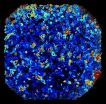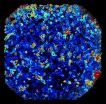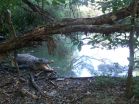Cells can use dynamic patterns to pluck signals from noise
2014-12-11
(Press-News.org) VIDEO:
A microscopy system continuously measures responses to signaling chemicals in thousands of cells at a time.
Click here for more information.
Scientists have discovered a general principle for how cells could accurately transmit chemical signals despite high levels of noise in the system, they report in Science this week.
A cell's response to outside chemical signals depends on its physiological state, which can fluctuate considerably. Amounts of different kinds of proteins within individual cells varies by as much as 25 percent.
"Compared with an engineered components such as a transistor, that's a lot of noise," says Roy Wollman, a professor of chemistry and biochemistry at the University of California, San Diego. "This requires a different kind of problem solving."
Wollman and colleagues combined advanced microscopic imaging with information theory to determine how cells might encode information about the level of incoming chemical signals, given their variable states.
They studied three different chemical communication systems - molecules outside the cells that effect three different kinds of changes within, each on a different time scale. One signal releases calcium from internal stores to diffuse freely through the cytoplasm within minutes. Another changes the shape of a responding molecule over about an hour. A third moves a protein from the cytoplasm to the cell nucleus where it interacts with DNA over about 10 hours.
Wollman's team recorded responses to the three signals with a microscopy system that continuously measures changes in thousands of cells at a time. They monitored more than nine-hundred thousand cells responding to varying levels of each of the three chemical signals.
No single measure captured the cells' responses in a way that accurately preserved information about the concentration of the chemical signal outside the cell. Instead, a measure that captured the change of the cell's responses over time accurately recorded the level of the incoming signal. And information theoretical analysis concluded that the 'noise' of varying cellular states could be eliminated in this way.
"It shows how to build a communication system that can function in the presence of so much noise," Wollman said.
INFORMATION:
The study is an example of quantitative biology, an approach to the study of life that aims to reveal fundamental principles that can predict how biological systems will work. Learn more about UC San Diego's quantitative biology program here: http://qbio.ucsd.edu.
Co-authors include Jangir Selimkhanov and Brooks Taylor, graduate students in bioengineering at UC San Diego who contributed equally to the work, Jason Yao and Anna Pilko in UC San Diego's department of chemistry and biochemistry, John Albeck of UC Davis, Alexander Hoffmann of UCLA, and Lev Tsimring of UC San Diego's Biocircuits Institute. Hoffmann, Tsimring and Wollman are also part of the San Diego Center for Systems Biology, which is supported by the National Institute of General Medical Sciences.
[Attachments] See images for this press release:


ELSE PRESS RELEASES FROM THIS DATE:
2014-12-11
The entire semiconductor industry, not to mention Silicon Valley, is built on the propensity of electrons in silicon to get kicked out of their atomic shells and become free. These mobile electrons are routed and switched though transistors, carrying the digital information that characterizes our age.
An international team of physicists and chemists based at the University of California, Berkeley, has for the first time taken snapshots of this ephemeral event using attosecond pulses of soft x-ray light lasting only a few billionths of a billionth of a second.
While ...
2014-12-11
CHAMPAIGN, Ill. - Where did the songbird get its song? What branch of the bird family tree is closer to the flamingo - the heron or the sparrow?
These questions seem simple, but are actually difficult for geneticists to answer. A new, sophisticated statistical technique developed by researchers at the University of Illinois and the University of Texas at Austin can help researchers construct more accurate species trees detailing the lineage of genes and the relationships between species.
The method, called statistical binning, was used in the Avian Phylogenetics Project, ...
2014-12-11
This news release is available in Spanish. 66 million years ago, the dinosaurs, as we think about them, became extinct, but certain reptiles and birds survived this mass extinction. The birds that survived experienced rapid evolution and diversification. Until now, explaining the family tree of modern birds has been a difficult and controversial subject amongst scientists. Thanks to the research of an international consortium involving researchers from the Centre for Genomic Regulation in Barcelona, we now have new clues about this evolution and further information ...
2014-12-11
FORT LAUDERDALE-DAVIE, Fla. - We all know that ducks, crows, falcons and egrets are birds. A group of scientists, however, wanted to dig deeper and unlock more about how these animals are related genetically. The idea was to investigate how modern species of birds emerged and evolved after the dinosaurs disappeared from the earth. This research included work from Stephen O'Brien, Ph.D., a professor at NSU's Oceanographic Center whose main focus in genomics.
Now findings from this research are being announced in several scientific publications, including Science magazine, ...
2014-12-11
A Texas Tech University biologist led a team of more than 50 scientists who mapped the genomes of three crocodilians.
By mapping these genomes, scientists may better understand the evolution of birds, which are the toothy predators' closest living relatives, said David Ray, an associate professor of biology. The team completed genomes of a crocodile, an alligator and a true gharial to complete the genomic family portrait.
Their research, largely funded by the National Science Foundation, will appear Friday (Dec. 12) in the peer-reviewed journal, Science.
"One of the ...
2014-12-11
Scientists from Nanyang Technological University (NTU) have discovered exactly how the malaria parasite is developing resistance towards the most important front-line drugs used to treat the disease.
Malaria is a mosquito-borne parasite which affects over 60 million people worldwide and in serious cases, can be fatal. There is currently no viable vaccine for malaria while antimalarial drugs and prophylaxis are losing its efficacy with increasing drug resistance.
NTU Associate Professor Zbynek Bozdech, who led an international research team from 11 different countries, ...
2014-12-11
The first findings of the Avian Phylogenomics Consortium are being reported nearly simultaneously in 28 papers -- eight papers in a Dec. 12 special issue of Science and 20 more in Genome Biology, GigaScience and other journals. The full set of papers in Science and other journals can be accessed at avian.genomics.cn
Scientists already knew that the birds who survived the mass extinction experienced a rapid burst of evolution. But the family tree of modern birds has confused biologists for centuries and the molecular details of how birds arrived at the spectacular biodiversity ...
2014-12-11
New research from the University of Kent suggests that chickens and turkeys have experienced fewer gross genomic changes than other birds as they evolved from their dinosaur ancestor.
Professor Darren Griffin and a team at the University's School of Biosciences have conducted research that suggests that chromosomes of the chicken and turkey lineage have undergone the fewest number of changes compared to their ancient avian ancestor, thought to be a feathered dinosaur.
The Kent research is part of a study by a consortium of leading scientists into avian or bird genomes, ...
2014-12-11
An international team of scientists has completed the largest whole genome study of a single class of animals to date. To map the tree of life for birds, the team sequenced, assembled and compared full genomes of 48 bird species representing all major branches of modern birds including ostrich, hummingbird, crow, duck, falcon, parrot, crane, ibis, woodpecker and eagle species. The researchers have been working on this ambitious genetic tree of life, or phylogeny, project for four years.
As part of the Avian Phylogenomics Consortium -- comprised of more than 200 scientists ...
2014-12-11
NEW YORK, NY (December 11, 2014) Growing resistance to malaria drugs in Southeast Asia is caused by a single mutated gene inside the disease-causing Plasmodium falciparum parasite, according to a study led by David Fidock, PhD, professor of microbiology & immunology and of medical sciences (in medicine) at Columbia University Medical Center.
This finding provides public health officials around the world with a way to look for pockets of emerging resistance and potentially eliminate them before they spread.
Though malaria deaths have dropped by 30 percent worldwide since ...
LAST 30 PRESS RELEASES:
[Press-News.org] Cells can use dynamic patterns to pluck signals from noise




